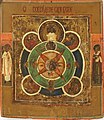Eye of Providence (icon)
 From Wikipedia - Reading time: 3 min
From Wikipedia - Reading time: 3 min

The Eye of Providence or the All-Seeing Eye of God (Russian: «Всевидящее око Божие») is a type of Orthodox icon that emerged in Russian iconography in the 19th century. The image of the Eye of Providence, inscribed in a triangle, appeared in the paintings of Russian Orthodox churches from the end of 18th century to the first half of 19th century, later in the Russian iconography, mostly notably among the Old Believers. It is a symbolic and allegorical composition of the words from the Holy Scripture that represents the omniscient and vigilant all-seeing eye of Christ.[1]
Description
[edit]
This icon is a symbolic and allegorical composition of the words form the Bible: “Behold, the eyes of the Lord are on those who fear Him, on those who hope in His mercy.” (Psalms 33:18)[1][2]
At the heart of the composition of such icons is the recurring motif of circles. In the central circle, Jesus Christ is depicted in the iconographic image of the Saviour Emmanuel with a blessing gesture. From this circle on the diagonal proceed 4 rays, on their tops are 4 small circles, inside of which are the allegorical symbols of the evangelists (see tetramorph), or less often, the images of the four evangelists themselves.
Fragments of the human face – eyes, nose and mouth are placed in the segments of the next circle. Above this circle on the central axis depicted the Virgin Mary with arms raised.
The next circle is green or red, it can represent the sky, sometimes starry. In the outermost circle usually depicted seraphim, or angels with scrolls. Above it on the central axis is a truncated circle, in which the heaven is depicted, God the Father with a gesture of blessing is seen in this circle. From God the Father emanates the Holy Spirit, descending in the form of a dove on the head of the Theotokos.[1][3]
The inscriptions found in the icon:
- Around the red face: “The Burning Coal appeared to Isaiah, the sun arose from the virgin’s womb, bringing to those who wandered in darkness the light of the knowledge of God.”
- Around the green circle is the Ode of the Theotokos: “My soul magnifies the Lord, and my spirit has rejoiced in God my Savior. For He has regarded the lowly state of His maidservant.” (Luke 1:46–48)
- Around the blue circle: “Your eyes will be upon the faithful of the land, and greet them with cherubim who glorifying God.”
- Around God the Father and outermost circle is the Hymn of Victory: “Holy, holy, holy, the glory of the Lord of Hosts is full of heaven and earth.”
- Around the innermost circle is the Greater Doxology: “Glory to God in the highest, and on earth peace, goodwill toward men.” (Luke 2:14)
Controversy
[edit]Some modern clergymen do not approve the use of such icons. Metropolitan Hilarion considers that such icons “are not canonical, they do not correspond to any church text and believers should not pray in front of them.”[4]
Gallery
[edit]References
[edit]- ^ a b c Всевидящее Око Божие. iconrussia.ru (in Russian). Retrieved 2018-01-28.
- ^ English text from The Orthodox Study Bible. Nashville: Thomas Nelson, Inc. 2008. p. 703. ISBN 978-0-7180-0359-3.
- ^ ВСЕВИДЯЩЕЕ ОКО БОЖИЕ. blagoslovenie.su (in Russian). Retrieved 2018-01-29.
- ^ Является ли канонической иконой образ «Всевидящее око»?. vera.vesti.ru (in Russian). Retrieved 2018-01-29.
 KSF
KSF
